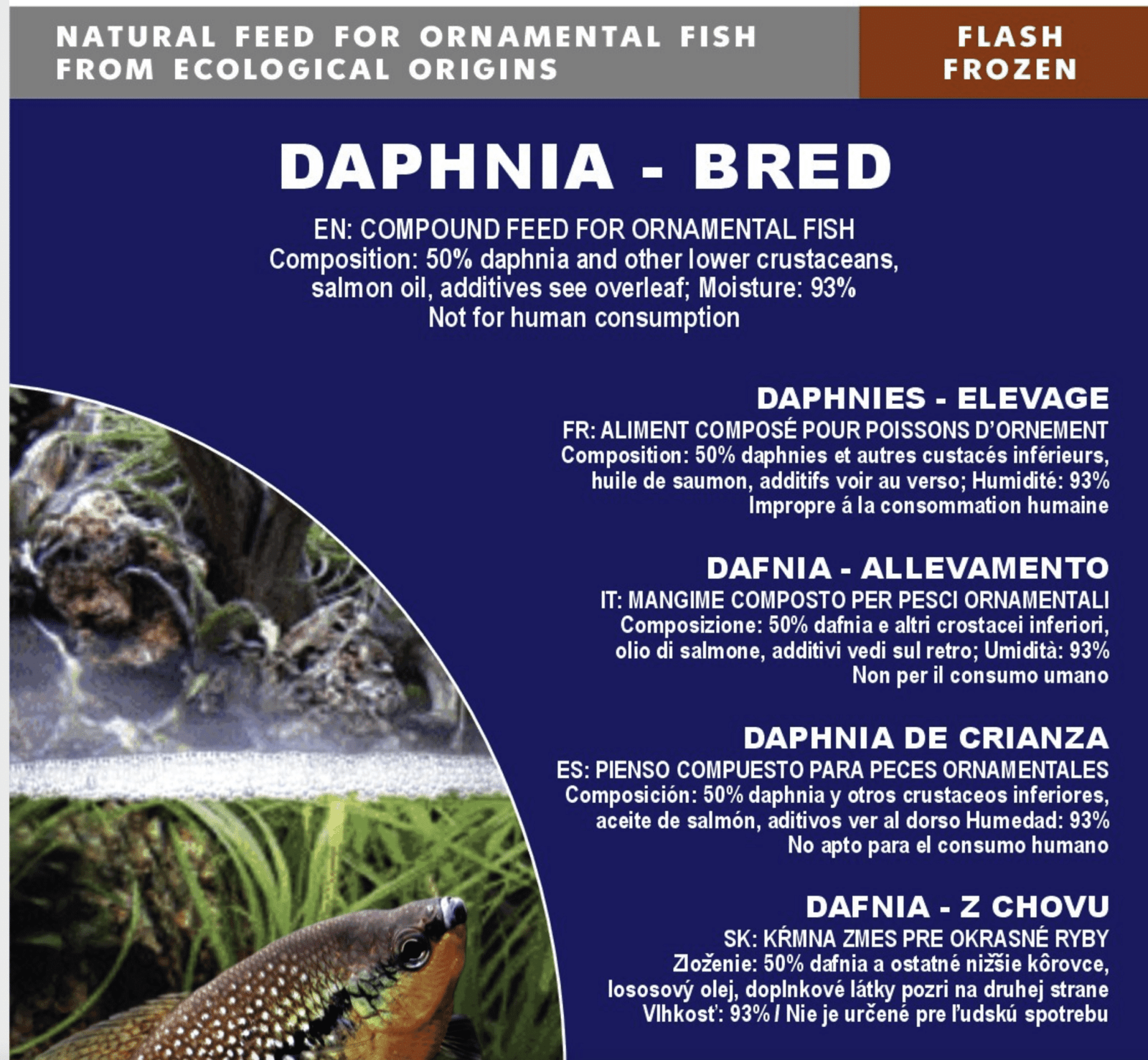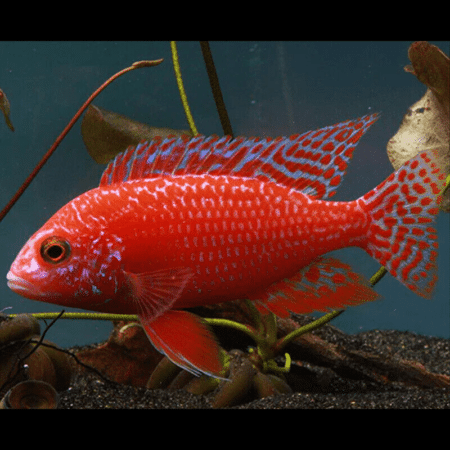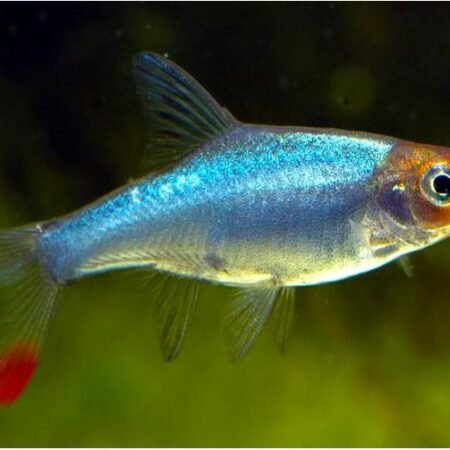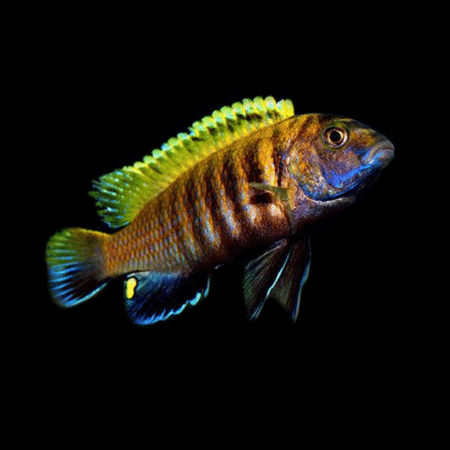6X100G Daphnia Bred Blister – Farm-Raised Daphnia Flash-Frozen Cubes, High-Protein Frozen Food for Thriving Aquarium Fish, Perfect for Nourishing Community Tank Friends, A Treat for Your Aquatic Companions
£14.49 Original price was: £14.49.£12.00Current price is: £12.00.
Welcome these beautiful creatures into your aquarium with our 6X100G Daphnia Bred Blister. These farm-raised, flash-frozen daphnia cubes are high in protein, nourishing your aquarium fish and enhancing their natural beauty. Perfect for community tanks, they promote flourishing aquatic life.
Species Introduction
Daphnia, commonly referred to as water fleas, are small crustaceans that play a vital role in aquatic ecosystems. These graceful creatures are found in freshwater environments worldwide, thriving in ponds, lakes, and marshes. Daphnia are known for their unique swimming patterns and their ability to reproduce rapidly, making them a staple food source for many fish species. Farm-raised Daphnia are specifically cultivated under controlled conditions to ensure high nutritional value and optimal health for aquarium fish. Their natural habitat consists of nutrient-rich waters where they feed on algae and organic matter, contributing to the health of the aquatic ecosystem. By providing Daphnia to your aquarium, you not only nourish your fish friends but also mimic their natural feeding habits, enhancing their overall well-being.
Care Requirements Dashboard
Essential Care Guide for Your Daphnia
| Optimal Living Conditions | |
|---|---|
| Water Temperature | 24-27°C (75-81°F) |
| pH Level | 6.5-7.5 |
| Water Hardness | 4-12 dKH |
| Minimum Tank Size | 80L (20 gal) |
| Salinity | Freshwater |
| Care Level | Beginner Friendly |
✓ Care Level: Easy
To successfully integrate Daphnia into your aquarium, it is essential to understand their care requirements. Daphnia thrive in a well-maintained environment, with a recommended tank size of at least 80 liters to allow for adequate swimming space and population growth. The ideal water parameters include a pH range of 6.5 to 7.5, a temperature between 24°C to 27°C (75°F to 81°F), and moderate hardness levels. Regular water changes are necessary to maintain water quality, as Daphnia are sensitive to pollutants and excessive waste. Providing a well-cycled tank with stable conditions will promote healthy Daphnia populations, ensuring a continuous food source for your aquatic companions. Remember, maintaining optimal water quality is crucial for the health of both Daphnia and your fish friends.
Natural Behavior & Temperament
Daphnia exhibit intriguing natural behaviors that contribute to their role in the aquatic food chain. They are known for their characteristic hopping and swimming motions, which are not only fascinating to observe but also serve as a means of evading predators. In a community tank setting, Daphnia can be seen swimming in the water column, where they filter feed on microscopic algae and organic particles. Their social behavior is generally peaceful, making them an excellent addition to community tanks. Daphnia are also capable of rapid population growth under favorable conditions, which can lead to fluctuations in their numbers. This natural reproductive strategy ensures that there is always a sufficient food supply for your fish friends, while also allowing for a dynamic and engaging aquarium environment.
Tank Setup Guide
Creating an ideal environment for Daphnia involves careful consideration of tank setup and decorations. A spacious tank with ample swimming room is essential, as Daphnia thrive in open water. Use a fine substrate to prevent detritus buildup, and consider incorporating live plants to provide natural cover and enhance water quality. Floating plants can also serve as a refuge for Daphnia, allowing them to escape from potential predators. Maintaining a gentle water flow will help distribute nutrients and keep Daphnia suspended in the water column. Additionally, ensure that the tank is equipped with a reliable filtration system to maintain water clarity and quality. By recreating their natural habitat, you will promote healthy Daphnia populations and, in turn, support the health of your aquarium fish.
Water Quality Management
✓ Water Parameters: pH 6.5-7.5, Temperature 24-27°C
Maintaining optimal water quality is crucial for the health and well-being of Daphnia. Regular testing of water parameters, including pH, temperature, and hardness, is essential to ensure a stable environment. Daphnia prefer a slightly acidic to neutral pH, with temperatures ranging from 24°C to 27°C. It is important to avoid drastic fluctuations in temperature, as this can stress the Daphnia and lead to population declines. Regular water changes, approximately 10-20% weekly, will help remove excess waste and replenish essential nutrients. Additionally, using a high-quality water conditioner can help neutralize harmful chemicals, ensuring a safe environment for both Daphnia and your fish friends. By prioritizing water quality management, you will foster a thriving ecosystem in your aquarium.
Feeding & Nutrition
✓ Diet: Algae, organic matter, Daphnia cubes
Feeding Daphnia is a straightforward process, as they are natural filter feeders that thrive on a diet of algae and organic matter. When providing Daphnia cubes as a food source for your fish friends, it is essential to consider their nutritional needs. Daphnia are high in protein and essential fatty acids, making them an excellent choice for promoting growth and vitality in aquarium fish. For optimal results, feed your fish friends small amounts of Daphnia several times a day, ensuring that they consume the food within a few minutes to prevent water quality issues. Additionally, Daphnia can be supplemented with high-quality flake or pellet foods to provide a balanced diet. By offering a diverse diet, you will enhance the health and well-being of your aquatic companions.
Compatibility Guide
Daphnia are generally compatible with a wide range of fish species, making them an ideal food source for community tanks. Small to medium-sized fish, such as tetras, guppies, and bettas, will eagerly consume Daphnia, benefiting from their high nutritional content. However, it is important to avoid keeping Daphnia with larger predatory fish that may consume them before they can thrive in your aquarium. Additionally, consider the social dynamics of your tank; Daphnia thrive in environments with peaceful fish species that do not exhibit aggressive feeding behaviors. By carefully selecting tank mates, you can create a harmonious environment where both Daphnia and your fish friends can flourish.
Health & Wellness
✓ Common Issues: Overpopulation, water quality
Maintaining the health and wellness of Daphnia is essential for ensuring a consistent food supply for your fish friends. Common issues include overpopulation, which can lead to competition for resources and deteriorating water quality. To prevent overpopulation, monitor the Daphnia population closely and adjust feeding amounts accordingly. If necessary, consider harvesting excess Daphnia to maintain a balanced ecosystem. Additionally, watch for signs of stress or illness, such as changes in swimming behavior or coloration. Regular water testing and maintenance will help prevent health issues and promote a thriving Daphnia population. By prioritizing the health of Daphnia, you will ensure a sustainable food source for your aquatic companions.
Breeding Information
Daphnia are known for their remarkable reproductive capabilities, which can be harnessed to maintain a steady food supply in your aquarium. Under optimal conditions, Daphnia can reproduce both sexually and asexually, with females capable of producing numerous offspring in a short period. To encourage breeding, provide a well-maintained environment with stable water parameters and ample food sources. When conditions are favorable, Daphnia will thrive and multiply rapidly, resulting in a flourishing population. It is essential to manage the population to prevent overcrowding, which can lead to stress and health issues. By understanding Daphnia breeding behavior, you can ensure a sustainable food source for your fish friends while enjoying the fascinating dynamics of their life cycle.
Acclimation Process
✓ Acclimation: Gradual introduction
Acclimating Daphnia to your aquarium is a crucial step in ensuring their health and well-being. When introducing Daphnia to a new environment, it is essential to acclimate them gradually to prevent shock. Start by floating the sealed bag of Daphnia in the aquarium for about 15-20 minutes to equalize the temperature. After this, slowly add small amounts of aquarium water to the bag over the course of an hour, allowing the Daphnia to adjust to the new water conditions. Once acclimated, gently release the Daphnia into the tank, avoiding the introduction of any transport water that may contain contaminants. By following a proper acclimation process, you will help ensure a smooth transition for your Daphnia, promoting their health and vitality in your aquarium.
Long-term Care
Long-term care of Daphnia involves maintaining a stable and healthy environment that supports their growth and reproduction. Regular monitoring of water parameters, including pH, temperature, and hardness, is essential to ensure optimal living conditions. Additionally, providing a balanced diet and managing the population will contribute to the overall health of Daphnia in your aquarium. As Daphnia grow and reproduce, it is important to keep an eye on their population density to prevent overcrowding and competition for resources. By implementing these long-term care strategies, you will foster a thriving Daphnia population that serves as a sustainable food source for your aquatic companions.
Natural Habitat Recreation
✓ Biotope: Freshwater ponds and lakes
Recreating the natural habitat of Daphnia in your aquarium can enhance their well-being and promote healthy populations. Daphnia thrive in freshwater environments rich in organic matter and algae. To mimic their natural habitat, consider incorporating live plants that provide cover and contribute to water quality. Additionally, maintaining a gentle water flow will help distribute nutrients and keep Daphnia suspended in the water column. Regularly introducing organic matter, such as decaying leaves or plant material, can also promote a balanced ecosystem that supports Daphnia growth. By recreating their natural habitat, you will create a thriving environment for Daphnia and a sustainable food source for your fish friends.
Seasonal Care Adjustments
✓ Adjustments: Monitor temperature and light
As seasons change, it is important to adjust the care of Daphnia to accommodate fluctuations in temperature and light. In warmer months, ensure that the water temperature remains within the ideal range of 24°C to 27°C, as higher temperatures can stress Daphnia and lead to population declines. Additionally, consider adjusting the lighting schedule to mimic natural day lengths, as this can influence Daphnia reproduction and growth. Regular monitoring of water quality and parameters will help identify any necessary adjustments, ensuring a stable environment for Daphnia throughout the year. By being proactive in seasonal care adjustments, you will support the health and vitality of Daphnia in your aquarium.
Expert Tips
✓ Professional Advice: Monitor population and water quality
For those looking to optimize the care of Daphnia in their aquarium, here are some expert tips to consider. First, regularly monitor the Daphnia population to prevent overcrowding, which can lead to competition for resources and stress. Implementing a harvesting routine can help maintain a balanced population while providing a consistent food source for your fish friends. Additionally, investing in a high-quality water testing kit will allow you to keep track of essential parameters, ensuring a stable environment for Daphnia. Finally, consider creating a dedicated Daphnia culture tank to maintain a continuous supply without impacting your main aquarium. By following these expert tips, you will enhance the care and sustainability of Daphnia in your aquarium.
Troubleshooting
✓ Common Problems: Water quality, overpopulation
When caring for Daphnia, you may encounter common issues that require troubleshooting. Poor water quality can lead to stress and population declines, so regular testing and maintenance are essential. If you notice a decline in Daphnia numbers, check for excess waste or pollutants in the water. Implementing regular water changes and ensuring proper filtration can help mitigate these issues. Additionally, overpopulation can lead to competition for resources, resulting in stunted growth and health problems. Monitor the population closely and consider harvesting excess Daphnia to maintain a balanced ecosystem. By addressing these common problems promptly, you can ensure a thriving Daphnia population in your aquarium.
Scientific Background
✓ Taxonomy: Crustacea, Cladocera
Daphnia belong to the class Crustacea and the order Cladocera, which encompasses a diverse group of small aquatic crustaceans. They are characterized by their segmented bodies, large antennae, and distinct carapace. The scientific study of Daphnia has provided valuable insights into their ecological roles and reproductive strategies. Research has shown that Daphnia are sensitive to environmental changes, making them important indicators of water quality and ecosystem health. Furthermore, their rapid reproduction rates and role as a food source for many fish species highlight their significance in aquatic food webs. By understanding the scientific background of Daphnia, aquarists can better appreciate their importance in maintaining healthy aquarium ecosystems.
Advanced Care Techniques
✓ Techniques: Culturing, nutrient enrichment
For aquarists looking to take their Daphnia care to the next level, advanced techniques can enhance their populations and nutritional value. Culturing Daphnia in a separate tank allows for better control over their environment and feeding. Consider enriching their diet with high-quality algae powders or yeast to boost their nutritional content, which will benefit the fish that consume them. Additionally, maintaining optimal water conditions and regularly harvesting excess Daphnia can help sustain a healthy culture. By implementing these advanced care techniques, you will not only support the health of Daphnia but also provide a high-quality food source for your aquatic companions.
Frequently Asked Questions
Q: How much Daphnia should I feed my fish?
Feeding your fish the right amount of Daphnia is crucial for their health. A good rule of thumb is to offer a portion that your fish can consume within 2-3 minutes, 2-3 times a week. Overfeeding can lead to poor water quality as uneaten food decomposes. Observe your fish; if they seem to be eagerly feeding, you can slightly increase the portion, but always avoid excess. Adjust the feeding frequency based on your fish’s activity and size, ensuring they maintain a balanced diet alongside other food types.
✓ Expert Tip
Consider using Daphnia as a treat or supplement to a varied diet for optimal nutrition.
Q: How should I store Daphnia after opening?
To maintain the freshness of your Daphnia, it is essential to store it properly. Keep the unopened blister packs in the freezer until you are ready to use them. Once opened, transfer any unused Daphnia to an airtight container and return it to the freezer immediately. Avoid refreezing thawed food, as it can compromise the nutritional quality. Always ensure the container is tightly sealed to prevent freezer burn and contamination, thus preserving the high protein content that benefits your fish.
✓ Expert Tip
Label the container with the date of opening to track freshness.
Q: Which fish species can consume Daphnia?
Daphnia is an excellent food source for a wide range of freshwater and marine fish. Species such as Tetras, Guppies, and Betta fish particularly benefit from its high protein content. Additionally, many fry and juvenile fish thrive on Daphnia as it promotes healthy growth. Larger fish, such as Cichlids and even some marine species, can also enjoy it. However, ensure that the size of the Daphnia is appropriate for your fish; smaller fish may struggle with larger pieces. Always monitor your fish’s feeding behaviour to ensure they are adequately consuming the food.
✓ Expert Tip
Consider introducing Daphnia gradually to ensure your fish adjust well to this new food source.
Q: Will feeding Daphnia affect my water quality?
Feeding Daphnia can impact your aquarium’s water quality if not managed properly. Uneaten food can decompose, leading to ammonia spikes which can harm your fish. To mitigate this, ensure you only feed what your fish can consume in a few minutes and remove any uneaten portions promptly. Regular water testing and maintenance, including partial water changes, are vital to maintaining optimal water quality. Additionally, incorporating a good filtration system can aid in managing waste effectively, promoting a healthy environment for your aquatic companions.
✓ Expert Tip
Monitor your water parameters regularly to ensure a stable environment for your fish.
Q: How does Daphnia support fish health and growth?
Daphnia is renowned for its high protein levels and essential fatty acids, which are vital for the growth and health of fish. These small crustaceans are rich in omega-3 fatty acids, promoting better growth rates and enhancing the overall vitality of your fish. The natural movement of Daphnia also stimulates hunting behaviours, which keeps your fish active and engaged. Furthermore, Daphnia can aid in digestion due to its fibrous structure, supporting gut health and reducing the risk of constipation in your aquatic companions.
✓ Expert Tip
Integrate Daphnia into a varied diet to maximise nutritional benefits for your fish.
Q: Can I mix Daphnia with other food types?
Mixing Daphnia with other food types can provide a more balanced diet for your fish. It is advisable to combine Daphnia with high-quality flakes or pellets to ensure your fish receive all necessary nutrients. This variety not only keeps your fish interested in their food but also helps meet the dietary needs of different species within your aquarium. When mixing, start with a small amount of Daphnia and gradually increase the quantity to observe how your fish respond to the combination.
✓ Expert Tip
Ensure that the other foods you mix with Daphnia are compatible with your fish’s dietary needs.
Q: How often should I feed Daphnia to breeding fish?
Breeding fish require a nutritious diet to support their reproductive health and the growth of their fry. It is beneficial to feed Daphnia daily during the breeding phase, as its high protein content aids in the development of eggs and fry. A varied diet including Daphnia, alongside other high-quality foods, will ensure that breeding fish receive comprehensive nutrition. Observe the fish’s behaviour and adjust feeding as necessary to maintain health and vitality during this critical time.
✓ Expert Tip
Monitor the growth of fry closely to ensure they are thriving on the diet provided.
Q: What are the signs of healthy fish when feeding Daphnia?
Healthy fish exhibit certain behaviours and physical traits when fed Daphnia. Look for active swimming, vibrant colours, and a good appetite as indicators of well-being. After feeding, fish should display natural foraging behaviour, eagerly seeking out the Daphnia. Additionally, observe their fins and skin; they should be smooth and free of lesions or discoloration. Any notable changes in behaviour, such as lethargy or refusal to eat, may indicate underlying health issues that require attention.
✓ Expert Tip
Regularly monitor your fish’s health to catch any issues early.
Q: How can I transition my fish to Daphnia?
Transitioning your fish to Daphnia should be done gradually to avoid digestive issues. Start by offering a small amount alongside their usual food. Observe their reactions; if they consume it without issue, you can slowly increase the quantity over time. Ensure that your fish are familiar with the texture and movement of Daphnia, as this can encourage natural hunting instincts. If they show reluctance, try chopping or crushing the Daphnia to make it more accessible, especially for smaller species.
✓ Expert Tip
Be patient during the transition; it may take time for your fish to accept new foods.














Emma Roberts (verified owner) –
As a caring fish parent, I’m always on the lookout for the best food options for my aquatic pets, and these 6X100G Daphnia bred blister cubes have truly impressed me! I started using them about two weeks ago, and the difference in my fish’s activity level and overall health is remarkable. My guppies and tetras go absolutely wild for these farm-raised daphnia! The flash-frozen process retains all the nutrients, ensuring my fish get the best possible diet. I’ve tried other frozen foods, but the quality of this product stands out—no mushy texture here!
I appreciate that they come in convenient cubes that are easy to thaw and feed, making my daily routine simpler. Plus, they’re packed with protein which is fantastic for my growing fry. If you’re looking to enhance your fish’s diet and happiness, I definitely recommend these frozen daphnia cubes. The only downside is that I wish they came in larger quantities; I might have to stock up next time. But overall, a fantastic addition to any aquarium enthusiast’s feeding regimen!
Emily Carter (verified owner) –
I recently purchased the 6X100G Daphnia Bred Blister for my community tank, and I couldn’t be happier with the results! As a caring fish parent, I always prioritize my fish’s health and happiness, and these flash-frozen daphnia cubes have quickly become a staple in my feeding routine. Within just a week of introducing them, I noticed my fish were more active and vibrant — they absolutely love these high-protein treats!
I’ve tried other frozen foods before, but the quality of these daphnia is exceptional. They are clean and well-packaged, and my fish seem to thrive on them, which is so gratifying to see. The blister packaging makes it super convenient to feed — just pop out a cube and it’s good to go! The only minor downside is that they can sometimes be a bit messy when thawing, but it’s a small trade-off for the joy they bring to my aquatic buddies.
I highly recommend this product for anyone with community tanks or picky eaters. It’s a fantastic way to enrich their diet and keep them healthy. I’ll definitely be purchasing it again!